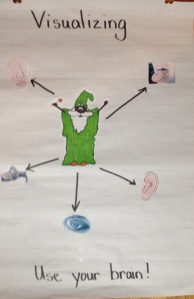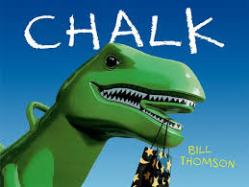I love everything about this book. The illustrations are amazing. I have used it in many classrooms at many grade levels. This particular lesson was for kindergarten visualizing, but I would recommend it for any elementary grade you want to engage in an adventure.
I talked to the students about what good readers do. We talked about how important it is to stop and think and try to get a picture in your head as you read. I introduced my Visualization Wizard and told the children that when we visualize we conjure up some or all of our senses to help us.
I introduced Adrienne Gear’s poem from her book Reading Power:
“You don’t close your eyes when you visualize,
You don’t close your eyes when you visualize,
You don’t close your eyes when you visualize,
You use your brain! yeah!” (we added in some snapping,clapping dancing…)
I said “visualize “ice cream” and think about it quietly.” Then we shared-I asked “what would you see,smell,taste,feel or hear? ” Everyone laughed at “hearing” ice cream. After sharing we talked about how not everybody visualized the same ice cream, because we don’t all see things in the same way.
We continued with visualizing “pizza” and ” a dog” . It really helps to do this orally, before trying to do it with a book.
I then proceeded to share the book Chalk stopping in key places to think and visualize…”get a picture in your head…” at the end of the book, students drew a picture with coloured chalk to show what they would draw if they had magic chalk.
Finally, we sat in a circle and shared our drawings and talked about what it would be like if the drawings came alive.
My next step will be to go to Adrienne Gear’s book and do the activity about Lollipops in her visualization chapter.
I will do this lesson again!!
Other books for visualizing :read more



